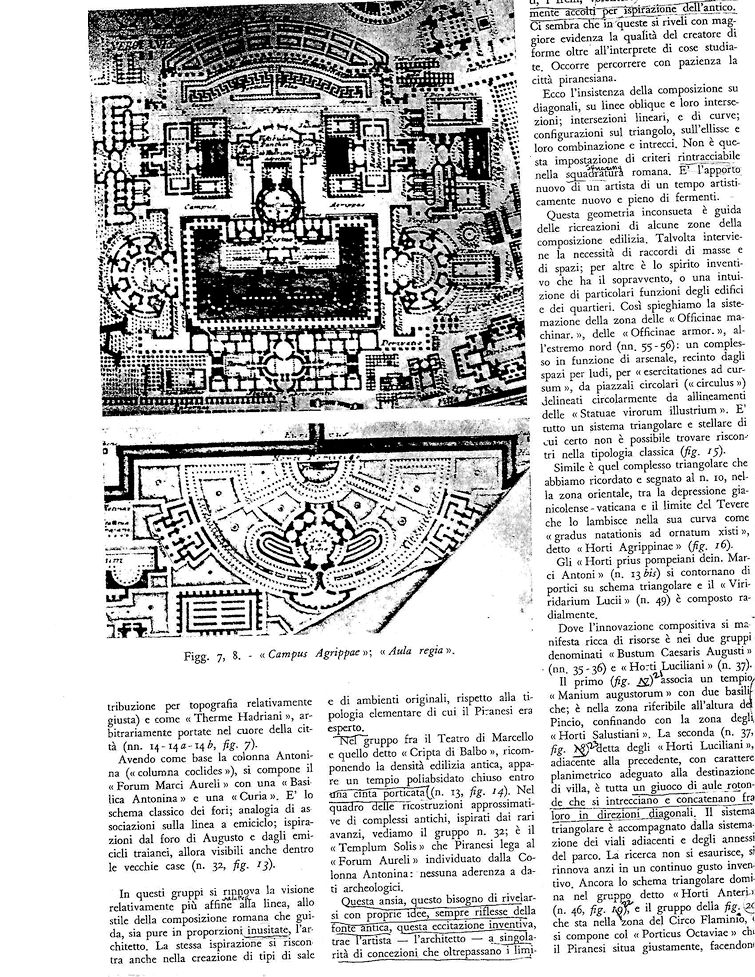
| |
Having the Column of Marcus Aurelius ("Columna Cochlida") as its focal point, the Forum of Marcus Aurelius is composed with a Basilica Antonina and a "Curia" (a place of assembly). It is the classic scheme of the forum; analogous associations based on the line and semicircle; inspired by the forum of Augustus and the Trajanesque semicircles, at that time visible even among the old houses.
In these groupings a vision largely related to the line is renewed, following the style of Roman composition, albeit with unusual proportions, which guides the architect. The same inspiration is likewise encountered in the creation of room types and of original surroundings, all with respect to the basis [Roman] typology of which Piranesi was an expert. emphasis added
In the grouping between the Theater of Marcellus and the Theater of Balbi which reconstructs the ancient urban density, there appears a multi-apsed temple surrounded by an arcaded enclosure. Of the type of reconstructions that approximate ancient complexes, inspired by the scarce remains, we see the Temple of the Sun ("Templum Solis") which Piranesi ties to the Forum of Marcus Aurelius identified by the Column of Marcus Aurelius: there is no adherence to archeological facts.
This craving, this need to reveal oneself with ideas of one's own, always reflecting on ancient sources, this inventive excitement, leads the artist - the architect - to a uniqueness of conception that surpasses the limits, the restraints, that are willingly and lovingly accepted when one is inspired by antiquity. It seems to us that here, revealed with greater evidence, are the qualities of a creator of forms that goes beyond that of an interpreter of things studied. One needs to travel through the Piranesian city with patience.
There we see the insistence of compositions based on the diagonal, on oblique lines and their intersection; intersections of lines and of curves: configurations based on the triangle, on the ellipse, and their combination and intermingling. This is not an imposition of criteria that can be traced back to the Roman grid iron. It is the novel contribution of an artist from a period which was artistically innovative and full of ferment.
This unusual geometry guides the re-creation of some zones of the built fabric. Sometimes the necessity to connect building masses and spaces intervenes; other times it is the spirit of invention that has the upper hand, or an intuition of the particular functions of the buildings or neighborhoods. This applies to the layout of the zone of the factory for making machines of war ("Officinae machinarum militarium") and the factory for making armor ("Officinae Armorum") at the extreme north of the plan: a complex which functions as an arsenal, surrounded by the spaces assigned to games and sports ("exercitationes ad cursum"), made up of circular plazas ("circulus"), ringed with statutes or tombs of famous men ("Statuae virorum illustrium"). It is a triangular and star-shaped system to which it is certainly not possible to find a comparison in classical typology.
A triangular complex of similar type is the Garden of Agrippina ("Horti Agrippinae"), which is in the eastern zone between the Janiculum-Vatican depression, and the edge of which laps into the Tiber as stairs with ornamental colonnades leading to a swimming area ("gradus natationis ad ornatum xisti").
The Gardens formerly of Pompey and thereafter of Marc Antony ("Horti prius pompeiani dein. Marci Antoni") are surrounded by arcades in a triangular scheme, and the Lucii game preserve ("Viridarium Lucii") is radially composed.
The compositional innovation manifests itself further with rich resources in the Burial Place of the Augustan family ("Bustum Caesaris Augusti") and the Gardens of Lucilian ("Horti Luciliani").
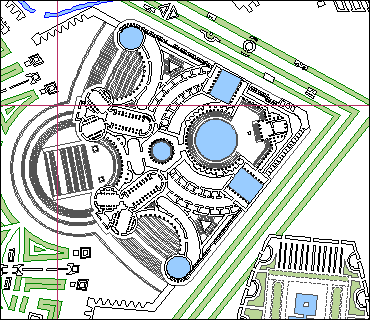
Bustum Caesaris Augusti - The Augustan Family Burial Place
The first joins the main Temple of Augustus ("Templum Manium Augustorum") with two basilicas; it is in the zone that corresponds to the heights of the Pincio Hill, bordering the zone of the Gardens of Salustian ("Horti Salustiani"). The second, adjacent to the first, having characteristics of a plan proper for its function as a villa, is all a game of round rooms that intertwine and link in diagonal directions. The triangular system is continued into the layout of the adjacent streets and the park annexes. The research does not exhaust itself, rather it renews itself in a continuous inventive relish. The triangular scheme again dominates the Gardens of Anteri ("Horti Anteri"), and also the group adjacent to the Circus of Flaminius, and is composed of the Portico of Octavius ("Porticus Octaviae"), which Piranesi sites correctly, forming the center of a public quarter; the building is in fact called a "Curia".
| |
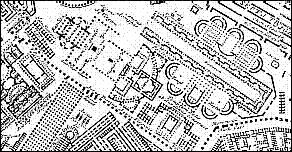
The Forum of Marcus Aurelius and the Temple of the Sun
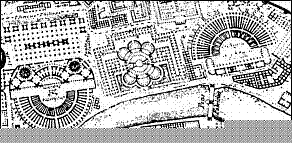
The Theater of Balbi and the Theater of Marcellus
"I am rather afraid that parts of the Campus which I describe should seem figments of my imagination and not based on any evidence: certainly if anyone compares them with the architectural theory of the ancients he will see that they differ greatly from it and are actually closer to the usage of our own times. But before anyone accuses me of falsehood, he should I beg, examine the ancient [Marble] plan of the city . . . he should examine the villas of Latium and that of Hadrian at Tivoli, the baths, the tombs and other ruins outside the Porta Capens and he will find that the ancients transgressed the strict rules of architecture just as much as the moderns. Perhaps it is inevitable and a general rule that the arts on reaching a peak should decline, or perhaps it is part of man's nature to demand some licience in creative expression as in other things which we sometimes criticise in buildings of out times."
--G.B.Piranesi from the dedication to Il Campo Marzio
In the following formal analysis, Fasolo lays heavy emphasis on triangular formations, which he sees as Piranesi's personal contribution to Roman architecture. The use of triangles within the Campo Marzio is not necessarily a design strategy that stems exclusively from Piranesi's own imagination, however. The existing physical conditions of the Campo Marzio and the other ancient sites Piranesi references are more likely the best guide to the design stategies used throughout the Ichnographia.
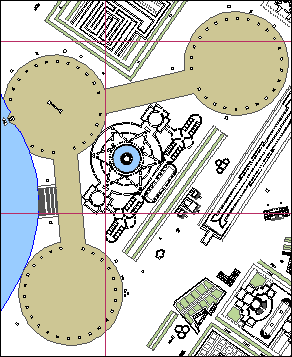
Officinae machinarum militarium/Officinae Armorum surrounded by the circular plazas for sports of games
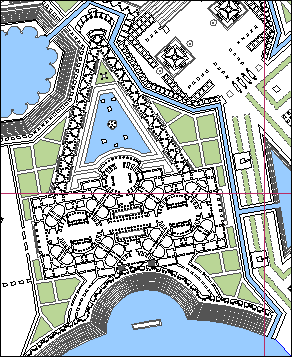
Horti Agrippinae and the stepped swimming area along the Tiber
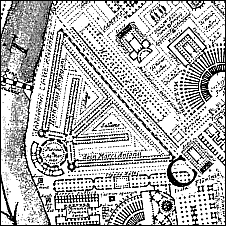
Horti prius Pompeiani dein. Marci Antoni - The Gardens fromerly of Pompey and thereafter of Marc Antony
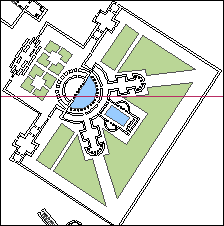
Viridarium Lucii - The Lucii Game Preserve
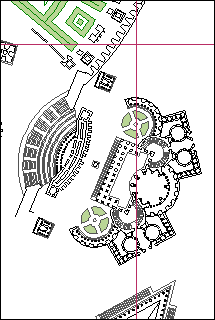
Horti Luciliani - The Gardens of Lucilian
|








